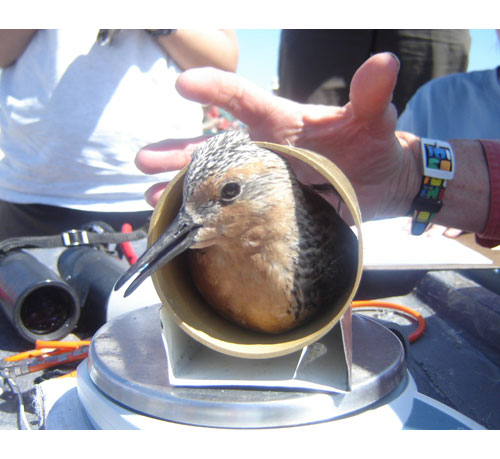With muffled booms, mortar-like cannons buried in the sand at the Delaware Bay beach hurl a long net over shorebirds foraging for horseshoe crab eggs along water’s edge. Teams of researchers and volunteers spring from hiding positions behind a low, scrub-covered dune, rushing to pull the net onto the beach.
For the 14th consecutive spring, researchers from around the world, led by the Department of Environmental Protection, have converged on the bay region to monitor and protect migrating shorebirds: red knots, ruddy turnstones, sanderlings, semipalmated sandpipers, dunlins and short-billed dowitchers.
But it’s the red knot, a species whose numbers in particular have plummeted in correlation with declines in horseshoe crabs and their eggs, that captures much of the attention – not to mention imagination.
“Delaware Bay is one of the most important bird stopovers in the world, and a critical stopover for these six species,” said Amanda Dey, principal zoologist with the DEP’s Endangered and Nongame Species Program. “The red knot is the poster child for all of these shorebirds ... but this is really a bay-wide problem.”
The researchers and volunteers are drawing blood samples, taking body measurements and placing coded leg bands on the birds in order to evaluate the health of these shorebird species. On this day, they are working on a small, picturesque cove in an area of Cape May County known as Pierces Point.
Over the years, New Jersey has taken the most aggressive actions in the Middle Atlantic region to save red knots, culminating in a 2008 legislative moratorium on harvesting horseshoe crabs until horseshoe crab eggs and red knots have rebounded.
This spring, researchers are seeing positive signs, but it’s much too soon to say whether the birds have turned the corner.
“I’m very hopeful we’ve stopped the decline,” said Clive Minton, an Australian researcher who developed the cannon-netting technique now used worldwide to study shorebirds. “I can say the ship has been halted, but I can't say it has turned around.”
The bay is critical because shorebirds need to pack on weight – and energy – as they continue migrating to breeding grounds in the Arctic. The red knot has the longest journey, an epic flight of as much as 10,000 miles from the tip of South America to the Canadian Arctic.
|
|
When knots arrive at Delaware Bay, they are mostly skin, feathers and bone. The only food suitable to pack on the calories they need: soft, easily digestible horseshoe crab eggs – and lots of them.
Once, the helmet-shaped and spike-tailed horseshoe crab, a living relic of the dinosaur age, was largely ignored by most people as little more than a curiosity. But in the 1990s, commercial demand quickly grew for horseshoe crabs as bait to catch conch.
|
studies to figure out what was going on. Niles continues to come to the bay as chief biologist with the Conserve Wildlife Foundation of New Jersey. Niles and Dey are married.
“We were never wrong. We predicted this would happen and it did,” Niles said of the steep declines in red knot populations. “If more people followed New Jersey’s lead in 1997, this would have never happened.”
Still, there are encouraging signs. Last |
 |
Place cursor over images below to view larger image.
Click on image to open in full size. |
|
|
|
|
|
|
|
 |
|
By the middle part of that decade, the DEP realized something was seriouslyamiss. Horseshoe crab eggs, once found in abundance along bay beaches, were becoming much harder to find. Once numbering up to 100,000 eggs per square meter of beach, numbers of eggs plummeted to just a few thousand per square meter.
At the same time, red knots counted through annual DEP-led ground and aerial surveys dropped from more than 40,000 in 1997 (and a high of more than 90,000 in 1989) to fewer than 20,000 throughout most of the last decade.
In 1997, Larry Niles, then chief of the Endangered Species Program, brought together teams of international experts, including Minton, to begin comprehensive |
year, 35 percent of red knots left the bay at the weight deemed sufficient to reach the Arctic and successfully breed – 180 grams, or a little more than six ounces. This is a vast improvement over the 15 percent that reached this weight in 2008, but is still far short of the 60 percent researchers believe is the minimum necessary to begin rebuilding the species.
So far this spring, the researchers are seeing more birds reaching the necessary weight. They’re also seeing more horseshoe crab eggs on the beaches.
“For the second consecutive year we’re seeing a good crab spawn,” Minton said. “That gets the season off to a good start. That’s the basic foundation.” |
|